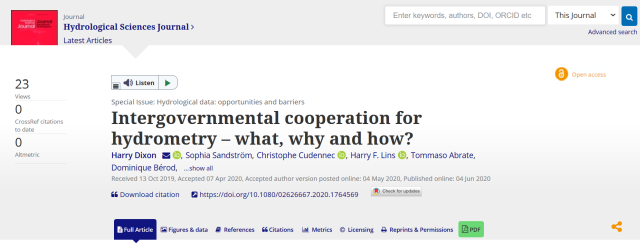IAHS News
Intergovernmental cooperation for hydrometry – what, why and how?
IAHS wish to highlight a new paper in the HSJ Special Issue on Hydrological data: opportunities and barriers which will be of interest to the members active in hydrometry across the world. The open access paper details the WMO mechanisms on hydrometry and illustrates the strong inputs IAHS provides as a partner to WMO activities in the field of hydrology.
Intergovernmental cooperation for hydrometry – what, why and how?
Harry Dixon, Sophia Sandström, Christophe Cudennec, Harry F. Lins, Tommaso Abrate, Dominique Bérod, Igor Chernov, Nirina Ravalitera, Daniel Sighomnou & Florian Teichert
https://www.tandfonline.com/doi/full/10.1080/02626667.2020.1764569
Two thirds of hydrological observation networks in developing countries are reported to be in poor or declining condition. At the same time innovation in sensor technologies and data processing are presenting opportunities for enhancing observation networks that are not being realized. The WMO HydroHub was launched in 2016 to transform assistance to operational water monitoring agencies around the world. If successful, the initiative will increase the amount of hydrometric data available to researchers, catchment managers and water policy makers. To those unfamiliar with UN organizations, however, the nature of such initiatives, the reasoning behind the decisions taken to establish them and the mechanisms by which they try to deliver benefits for society, can be opaque. This paper adopts a novel dialogue-style format to explore the set-up of the WMO HydroHub and build awareness amongst those who ultimately may benefit from its approaches.
This paper is just one example of the firm partnership between the IAHS and the Commission of Hydrology of WMO for over 50 years which ensures a link with the latest developments in the hydrological sciences. Together with UNESCO, IAHS and WMO award the annual International Hydrology Prize medals to two people who have made an outstanding contribution to hydrological science.

